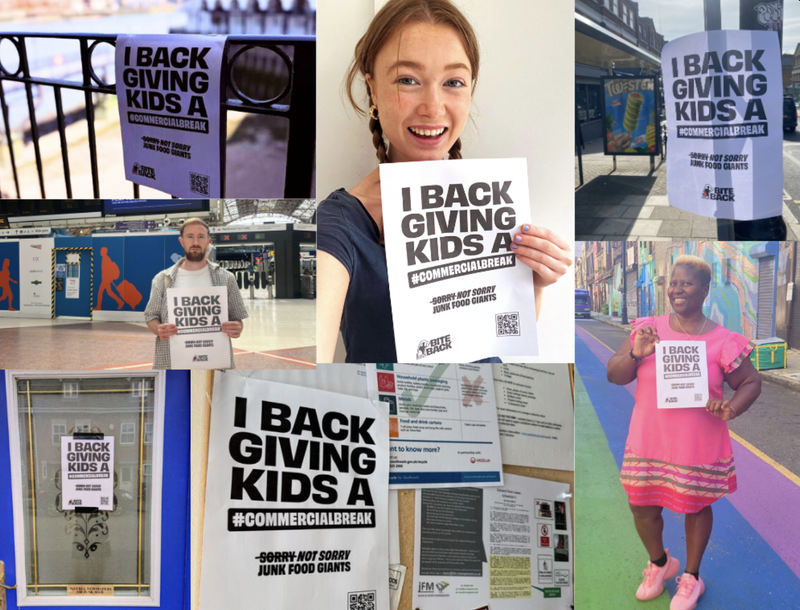Give Us A Commercial Break

Big food companies spend millions every year on marketing designed to do one simple thing — ensure their products are centre stage in our minds.
As a result, our streets are flooded with junk food ads. When young people walk to school, get on the bus, wait at a station, or just spend time in the town centre, they are surrounded. It’s inescapable.
Well, we’ve had enough — and we're fighting back.
GIVE KIDS A COMMERCIAL BREAK
We’ve flipped the script on the industry that’s flooded our world with junk by taking over hundreds of billboards carrying one bold message:
We bought this ad space so the junk food giants couldn’t — we’re giving kids a commercial break.

Farid's Story
Farid is 17, from Manchester, and he’s written about his experience:
"Since the day I was born, I’ve been targeted. There are three schools near me, and there’s a road that wraps around them — it is swamped with ads for unhealthy food and drinks. Practically all the bus stops where I live are covered in junk food adverts.
The truth is, this isn’t normal. It isn’t normal to feel trapped and surrounded by junk food ads. And it isn’t normal for my younger brother to have Big Food’s slogans embedded in his memory — he hasn’t even reached his teens yet."
Read Farid's latest blog here.
THE EXTENT OF THE PROBLEM
Our latest research reveals how deep junk food advertising is embedded in our streets — and how it hits the poorest communities the hardest. [1]
We found that in just the past year (2024), food and drink companies spent over £400 million on street advertising. The top 10 spenders included McDonald’s, PepsiCo, KFC, Coca-Cola, Mars, Mondelez and Red Bull. [2]
In partnership with the University of Liverpool, we surveyed four areas — Newcastle, Liverpool, Birmingham and Southwark — and found that over half (57%) of all the food and drink ads were for unhealthy products. [1]
Worse yet, our research found that unhealthy advertising is heavily targeting underserved communities. Junk food ads are six times more likely to appear in these areas than in the wealthiest areas.
Newcastle stood out as one of the worst hit — a city where ads for burgers, crisps and milkshakes dominated, and three quarters (77%) of all food and drink ads were for unhealthy products.

These graphs from our report show the rate of junk food adverts by quintile of deprivation across each location (most deprived = IMD Q1; least deprived = IMD Q5).
UPDATE: BITING BACK AGAINST CENSORSHIP
When we launched our #CommercialBreak campaign in April, we had no idea that we would face censorship by two of the UK’s biggest advertising companies. Both Global and JC Decaux — who are estimated to control around 70% of the country's digital outdoor ad impressions — have said that they will not run our billboard ad again. Even though, according to the Committee of Advertising Practice (CAP), we’ve broken no rules. All the while Big Food is free to continue plastering our streets with junk food ads.
When we told our supporters that our voices had been silenced, the reaction was explosive! Thousands of people across the UK are backing our call for a #CommercialBreak by plastering their homes, shop windows, and community boards with our posters.

WHAT WE’RE FIGHTING FOR
Our award-winning campaign to give young people a #CommercialBreak from junk food ads has seen us take over huge billboards in London and show up in the boardrooms of global food giants. We even took the message to the halls of Parliament! But that same message was rejected by the UK’s biggest outdoor advertisers, censoring the voices of young people.
This is all at a time when giant food companies continue to increase advertising spend, including to children. [3] Right now, a third of children are leaving English primary schools facing a future of food-related illness. This isn’t right.
It’s time to break the cycle of poor health caused by relentless, unhealthy marketing and give power back to communities. Are you with us?
HOW YOU CAN SUPPORT US
We need our voices to be heard, not silenced. So, we’re biting back, and we need your support!
We’re calling on Health Secretary Wes Streeting to put an end to the bombardment of junk food ads young people experience every day — online, on TV and on our streets. Stand with us by emailing your MP, asking them to write to the Health Secretary. We need your MP's support to add power to our voices.
[1] Read more in our full report: Advertising. Are food giants bombarding young people on our streets?
[2] Nielsen (2025) Out of Home Advertising Spend Analysis
[3] Read more: Fast Food Giants Spending Record Sums on Marketing Tactics as Food Prices Soar — Bite Back, 2023